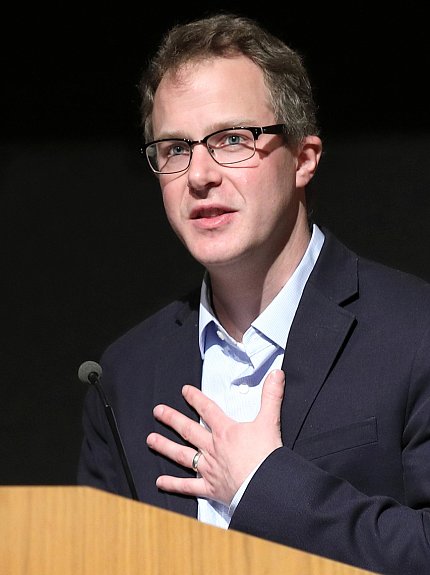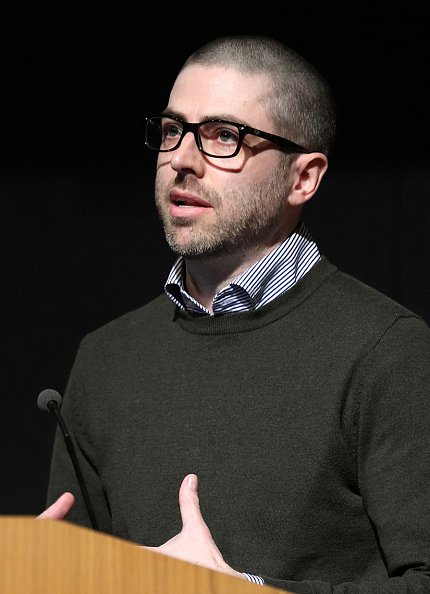Viral Networks, Reconnected
Scholars Use Digital Tools to Explore Medical History

Photo: Chia-Chi Charlie Chang
Some medical historians are looking at their research in a whole new light. Three of these scholars recently described their experiences using new digital platforms to bring a fresh perspective to their historical data.
The scholars, who spoke at an NLM forum recently in Lister Hill Auditorium, were among 10 researchers featured in the new peer-reviewed, open-access book Viral Networks: Connecting Digital Humanities and Medical History. The forum reunited the trio a year after a 2018 workshop at NIH where they explored how network analysis can provide useful insights into their data. The workshop, forum and book are part of a long-standing digital humanities partnership between NIH and the National Endowment for the Humanities.
The scholars all created databases, charts, graphs and other visualizations that grouped their data into one or more networks. Dr. Christopher Phillips, assistant professor of history at Carnegie Mellon University, created a network of biostatisticians at NIH in the 1940s who pioneered the use of statistics in clinical medicine. As Phillips mapped out what they wrote and where they published, he found new paths for exploration.
"One of the benefits I discovered from doing this kind of work is that there are statistical tools for measuring how important somebody is within a network," he said.

Photo: Chia-Chi Charlie Chang
Digital tools also can help uncover who or what might be missing from the historical record. For another project, Phillips is looking for anyone connected to, but who wasn’t publishing about, the 1964 Surgeon General’s report that definitively linked smoking to lung cancer. What went unsaid at the time? What previously unnamed sources paved the way to this discovery?
"Instead of simply taking chances in the archives following whatever papers happen to be kept, or following whatever reviews happen to be written," said Phillips, "this kind of digital humanistic tool enabled me to zoom back to find out who was missing in my earlier investigations and who was present and to ask new questions about the material."

Photo: Chia-Chi Charlie Chang
Dr. Sarah Runcie also used network analysis to create a new narrative based on information missing from the historical record.
Runcie, assistant professor of history, University of Louisiana at Lafayette, encountered a challenge while studying the history of public health in colonial Cameroon. During the mid-20th century, French doctors and Cameroonian medical auxiliaries would travel to rural villages to administer care. But all of the related data Runcie initially found was subjective, told from the perspective of European colonial administrators.
"I grappled with my interests in representing the African labor involved in these mobile teams, given that the numbers or the names of African medical personnel were generally not included in the data I was using to create my visualizations," she said.
She then set out to reframe the data. Runcie found that if she focused not on names but on titles and designations of team leaders, she could alleviate some of the research bias.
"Data is never neutral," she said. "Both how it’s produced and analyzed reflects values and systems of power...By running a different analysis of the exact same data, by [removing names of] European doctors, I could begin to uncover African medical labor in my network analysis."

Photo: Chia-Chi Charlie Chang
A third scholar featured in the book, Dr. Andrew Ruis, a researcher at the University of Wisconsin, is using networks to study the evolving definitions of nutrition over two centuries. He coded the definitions into physiological, ecological and behavioral categories as the concept of nutrition expanded over time.
"Nutrition is never just about food or even the chemical constituents of food," said Ruis. "There’s always been this idea that it’s connected to all sorts of other things—health and disease, economics and education, even cultural issues."
Ruis is currently using epistemic network analysis to study school wellness plans. Different districts emphasize different aspects of nutrition, such as healthful and unhealthful foods, obesity or lifelong wellness; his analyses allow for exploration of how nutrition is constructed across hundreds of school districts.
Networks encompass ideas, knowledge and communication. "Networks [also] are about people, how they connect to each other and how they change over time and space," said Viral Networks co-editor Dr. E. Thomas Ewing, a history professor at Virginia Tech. He considered this idea of social interconnectedness in choosing the book’s cover art, a black-and-white photo from the NLM digital archives of nurses at an Illinois training school that operated until 1929.

Photo: Chia-Chi Charlie Chang
As the medical historians featured in the book conducted their research, they found both limits and strengths of network analysis. Some scholars expressed concern that the new tech tools didn’t yield polished results, said co-editor Katherine Randall, a doctoral candidate at Virginia Tech.
"We embraced that," she said. "We encouraged authors to highlight the process of learning," which she added was invaluable to her as a junior scholar.
Said Randall, "I’m glad to have had the opportunity to be part of this collection that isn’t just about presenting polished research findings, but also about the messiness of research, the limitations of methods and the willingness to incorporate interdisciplinary approaches and see where they take you."
The Viral Networks book can be downloaded from NLM here: https://collections.nlm.nih.gov/catalog/nlm:nlmuid-101738722-pdf.
